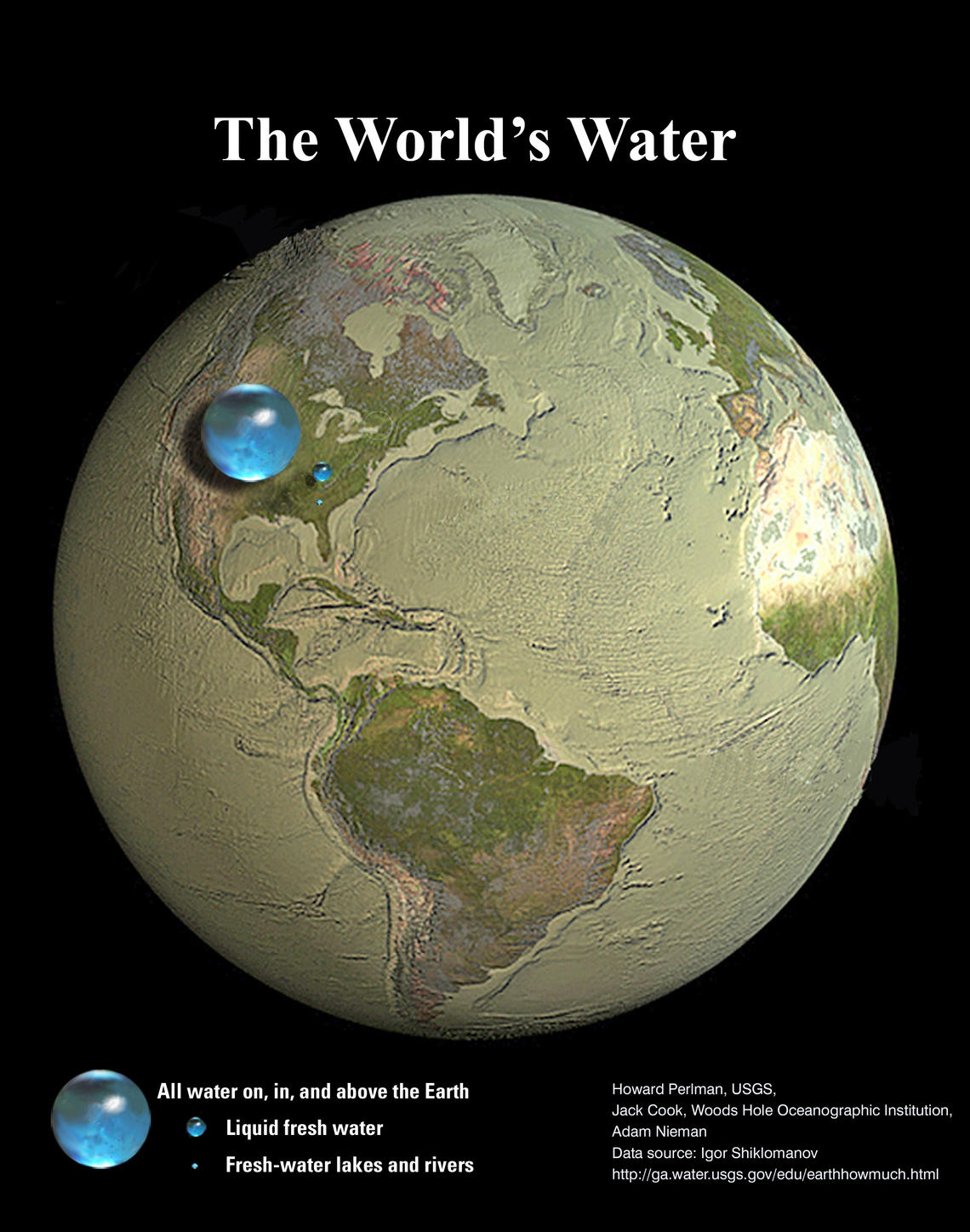The Earth is a watery place. But just how much water exists on, in, and above our planet? About 71 percent of the Earth's surface is water-covered, and the oceans hold about 96.5 percent of all Earth's water. Water also exists in the air as water vapor, in rivers and lakes, in icecaps and glaciers, in the ground as soil moisture and in aquifers, and even in you and your dog.
Water is never sitting still. Thanks to the water cycle, our planet's water supply is constantly moving from one place to another and from one form to another.

All Earth's water in a bubble
The globe illustration shows blue spheres representing relative amounts of Earth's water in comparison to the size of the Earth. The volume of the largest sphere, representing all water on, in, and above the Earth, would be about 1,386,000,000 cubic kilometers (km3), and be about 1,385 kilometers in diameter.
The smaller sphere represents Earth's liquid freshwater in groundwater, swamp water, rivers, and lakes. The volume of this sphere would be about 10,633,450 km3 and form a sphere about 272.8 kilometers in diameter. Yes, all of this water is freshwater, which we all need every day, but much of it is deep in the ground, unavailable to humans. Of total freshwater, over 69 percent is locked up in ice and glaciers. Another 30 percent of freshwater is in the ground.
Do you notice the "tiny" bubble? That one represents freshwater in all the lakes and rivers on the planet. Most of the water people and life on earth need every day comes from these surface-water sources. The volume of this sphere is 93,113 km3. The diameter of this sphere is about 56.2 kilometers.
Although surface water is used more to supply drinking water and to irrigate crops, groundwater is vital in that it not only helps to keep rivers and lakes full, it also provides water for people in places where visible water is scarce, such as in desert towns.
About 12,900 km3 of water, mostly in the form of water vapor, is in the atmosphere at any one time. If it all fell as precipitation at once, the Earth would be covered with only about 1 inch or 2.54 cm of water. Each day, 1,170 km3 of water evaporate or transpire into the atmosphere.
A cubic kilometer of water equals about 264 billion gallons (999 billion liters).
Global water distribution
|
Water source |
Water volume, in cubic kilometers |
Percent of |
Percent of |
|
Oceans, Seas, & Bays |
1,338,000,000 |
-- |
96.54 |
|
Ice caps, Glaciers, & Permanent Snow |
24,064,000 |
68.7 |
1.74 |
|
Groundwater |
23,400,000 |
-- |
1.69 |
|
Fresh |
10,530,000 |
30.1 |
0.76 |
|
Saline |
12,870,000 |
-- |
0.93 |
|
Soil Moisture |
16,500 |
0.05 |
0.001 |
|
Ground Ice & Permafrost |
300,000 |
0.86 |
0.022 |
|
Lakes |
176,400 |
-- |
0.013 |
|
Fresh |
91,000 |
0.26 |
0.007 |
|
Saline |
85,400 |
-- |
0.006 |
|
Atmosphere |
12,900 |
0.04 |
0.001 |
|
Swamp Water |
11,470 |
0.03 |
0.0008 |
|
Rivers |
2,120 |
0.006 |
0.0002 |
|
Biological Water |
1,120 |
0.003 |
0.0001 |
